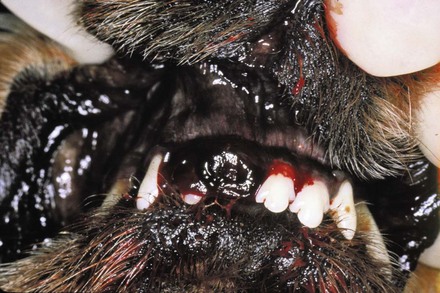12 Exodontics (Extractions)
When you have completed this chapter, you will be able to:
• Define exodontic and describe indications for this type of treatment.
• Discuss legal concerns related to performance of tooth extractions by veterinary technicians.
• List the instruments used for performing dental extractions and describe the function of each.
• Describe the procedure for removal of a single-rooted tooth.
• Describe the procedure for removal of a multirooted tooth.
• List and describe potential complications to tooth extraction.
The Technician and Extractions
The American Veterinary Dental College (AVDC), which represents board-certified veterinary dental specialists throughout the world, has evaluated the duties of the veterinarian, registered veterinary technician, and nonlicensed individuals in practice. As a result, the AVDC developed a position statement stipulating that only veterinarians should provide extraction services (Box 12-1).
Box 12-1
American Veterinary Dental College (AVDC) Position Statement Regarding Veterinary Dental Healthcare Providers
Tasks that May Be Performed by Dentists, Registered Dental Hygienists, and Other Dental Healthcare Providers
Adopted by the Board of Directors April 1998; revised October 1999 and September 2006. Courtesy American Veterinary Dental College (AVDC) at www.AVDC.org.
Instruments for Exodontics
A variety of instruments are used for extractions (Box 12-2). Dental elevators are used to engage teeth and raise them from the root socket. Extraction forceps grasp the tooth and remove it from the socket. Spring-loaded forceps are recommended (Figure 12-2). Another useful forceps is a root removal forceps (Figure 12-3).
Box 12-2
Instruments for Exodontics
Surgical extraction: Scalpel handle with blade (11 blade, 15c)
Periosteal elevator: Molt No. 2 (small patient) or Molt No. 4 (large patient)
Burs: Tapered crosscut bur, No. 701L for sectioning multirooted teeth
Dental elevators: 301SS, 301S, 301, 34
Winged elevators: 1-6 (7-10 are available for larger patients)
Root tip picks: Miltex 76, HB 11, Heidbrink
Irrigation solution: Sterile saline, dilute chlorhexidine solution
Periodontal scissors to release flap
Resorbable suture with swaged needle
Bone implant material: Consil (Nutramax Laboratories, Edgewood, MD)
Stay updated, free articles. Join our Telegram channel

Full access? Get Clinical Tree



